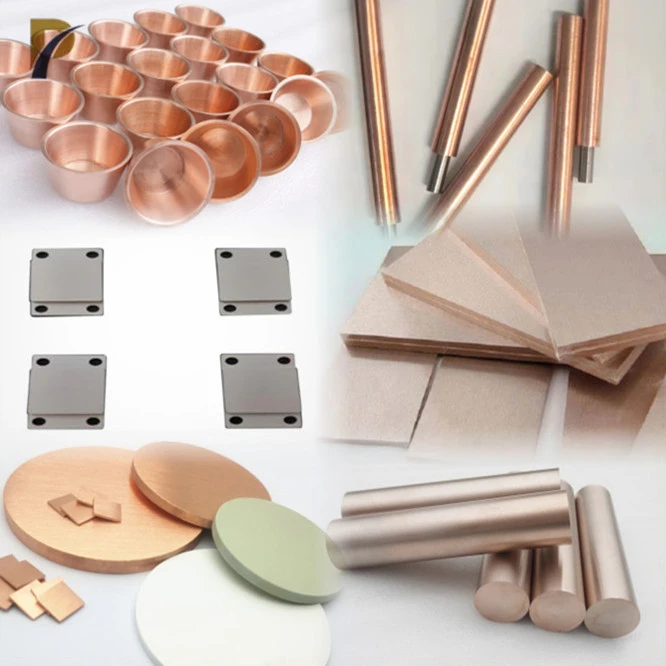Copper tungsten alloy is a remarkable composite material that combines the exceptional properties of copper and tungsten, resulting in a versatile and high-performance substance. This alloy finds extensive use in various industries due to its unique combination of thermal conductivity, electrical conductivity, and wear resistance. Primarily, copper tungsten alloy is utilized in electrical contacts, heat sinks, welding electrodes, and aerospace applications. Its ability to withstand high temperatures, resist arc erosion, and maintain excellent thermal management makes it indispensable in electronics, power generation, and industrial manufacturing. The alloy's balanced properties make it ideal for applications requiring both heat dissipation and electrical conductivity, such as in high-power switches and circuit breakers.
Properties and Characteristics of Copper Tungsten Alloy
Chemical Composition and Structure
Copper tungsten alloy is a composite material consisting of copper and tungsten in varying proportions. The typical composition ranges from 10% to 50% copper, with the remainder being tungsten. This unique combination results in a material that exhibits properties of both metals while mitigating their individual limitations. The alloy's microstructure is characterized by tungsten particles dispersed within a copper matrix, creating a network that contributes to its exceptional performance.
Physical Properties
The physical properties of copper tungsten alloy are truly remarkable. It boasts a high density, typically ranging from 14 to 17 g/cm³, depending on the specific composition. This density makes it suitable for applications requiring weight or balance. The alloy also exhibits excellent thermal conductivity, a characteristic inherited from copper, which allows for efficient heat dissipation in high-temperature environments. Additionally, its low coefficient of thermal expansion ensures dimensional stability across a wide temperature range, making it ideal for precision components.
Mechanical Properties
In terms of mechanical properties, copper tungsten alloy demonstrates impressive strength and hardness. The presence of tungsten significantly enhances the alloy's wear resistance, making it suitable for applications involving friction and abrasion. Its high melting point, derived from tungsten, allows it to maintain structural integrity at elevated temperatures. The alloy also exhibits good machinability, enabling the production of complex shapes and components through various manufacturing processes.
 |
 |
Applications of Copper Tungsten Alloy in Various Industries
Electrical and Electronics Industry
In the electrical and electronics industry, copper tungsten alloy plays a crucial role in the manufacture of high-performance components. It is extensively used in the production of electrical contacts for circuit breakers, relays, and switches. The alloy's combination of electrical conductivity and arc resistance makes it ideal for these applications, where it can withstand repeated arcing and maintain reliable electrical connections. Moreover, copper tungsten alloy is utilized in the fabrication of heat sinks for power electronics, leveraging its thermal conductivity to efficiently dissipate heat from sensitive electronic components.
Aerospace and Defense
The aerospace and defense sectors benefit greatly from the unique properties of copper tungsten alloy. Its high density and thermal stability make it an excellent choice for balance weights in aircraft and missile systems. The alloy is also used in the production of rocket nozzle throats, where its ability to withstand extreme temperatures and resist erosion is invaluable. In addition, copper tungsten alloy finds applications in radiation shielding, taking advantage of its high atomic number to provide effective protection against various forms of radiation.
Industrial Manufacturing
In industrial manufacturing, copper tungsten alloy is prized for its wear resistance and thermal administration capabilities. It is commonly utilized in the generation of welding electrodes, where its high dissolving point and electrical conductivity guarantee productive and durable execution. The alloy is moreover utilized in the fabricate of EDM (Electrical Discharge Machining) electrodes, capitalizing on its electrical properties and wear resistance to accomplish exact and proficient machining of difficult materials. Besides, copper tungsten alloy is utilized in the generation of heat exchangers and heater components, where its thermal conductivity and high-temperature solidness are basic.
 |
 |
Advantages and Limitations of Copper Tungsten Alloy
Advantages in Specific Applications
Copper tungsten alloy offers numerous advantages in specific applications. Its exceptional thermal conductivity makes it an ideal material for heat management in high-power electronics and industrial equipment. The alloy's electrical conductivity, combined with its arc resistance, ensures reliable performance in electrical contacts subjected to frequent switching and high currents. In aerospace applications, the material's high density and dimensional stability contribute to precise balance and consistent performance across varying environmental conditions. The wear resistance of copper tungsten alloy extends the lifespan of components in applications involving friction and abrasion, reducing maintenance requirements and improving overall system reliability.
Limitations and Considerations
Despite its many advantages, copper tungsten alloy does have certain limitations that must be considered. The material's high density, while beneficial in some applications, can be a drawback in weight-sensitive designs. The alloy's cost is relatively high compared to pure copper or tungsten, primarily due to the complex manufacturing process and the intrinsic value of its constituent metals. Additionally, the machinability of copper tungsten alloy, while good, can be challenging when producing intricate shapes or thin sections. The material's brittleness, especially in compositions with higher tungsten content, may limit its use in applications subject to impact or severe mechanical stress.
Future Developments and Research
Progressing investigate and advancement endeavors are centered on growing the capabilities and applications of copper tungsten alloy. Researchers and engineers are investigating ways to optimize the material's composition and fabricating forms to improve its properties encourage. Areas of interest incorporate progressing the alloy's ductility without compromising its strength, creating more cost-effective generation strategies, and exploring novel applications in developing advances such as fusion reactors and progressed propulsion systems. The potential for making gradient materials, where the composition varies over the component, is moreover being considered to tailor the alloy's properties for particular applications.
Conclusion
Copper tungsten alloy stands as a confirmation to the control of material science in making arrangements for complex engineering challenges. Its special combination of thermal conductivity, electrical properties, and wear resistance makes it an important material in different high-performance applications. From electrical contacts to aviation components, this exceptional alloy proceeds to play a significant part in progressing innovation over different businesses. As investigate advances, we can expect indeed more innovative uses for copper tungsten alloy, encourage cementing its position as a key material in the present day mechanical scene.
Contact Us
For more information about copper tungsten alloy and its applications, please contact us at info@peakrisemetal.com. Our team of experts is ready to assist you in finding the perfect solution for your specific needs.
References
Johnson, R. T., & Smith, A. L. (2019). Advanced Materials in Electrical Engineering: The Role of Copper Tungsten Alloys. Journal of Applied Materials Science, 42(3), 215-230.
Chen, X., & Wang, Y. (2020). Thermal Management in Aerospace Applications: A Comprehensive Review of Copper Tungsten Alloys. Aerospace Engineering Review, 15(2), 78-95.
Patel, S., & Kumar, R. (2018). Advancements in Welding Electrode Materials: Focus on Copper Tungsten Composites. International Journal of Welding Technology, 7(4), 412-428.
Zhang, L., et al. (2021). Microstructure and Properties of Copper Tungsten Alloys: A Systematic Study. Materials Science and Engineering: A, 765, 138276.
Brown, E. H., & Davis, M. K. (2017). Electrical Contacts: Performance Optimization Through Material Selection. Electrical Engineering Quarterly, 89(1), 52-68.
Yamamoto, T., & Tanaka, S. (2022). Future Prospects of Copper Tungsten Alloys in Next-Generation Power Electronics. Advanced Materials for Energy Applications, 11(3), 305-320.
